Technology can be a killer. A malfunctioning mail program and a dying desk top computer has prevented the production and mailing of these newsletters and posting a foraging class schedule. I also confused two class dates — my apologies — and lost 30 years of photos and writings, so November was pretty much a bust. And a bobcat ate my duck and chickens.
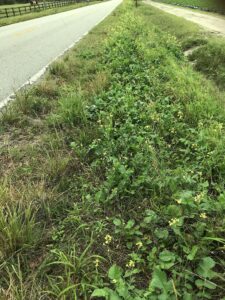
This is the common place to find mustard or radish plants this time of year, a streak of yellow blossoms beside the road. Photo By Green Deane
Chilly nights have accentuated our wild mustards. Where I live they are blooming along the road ways. Up north that happens in late spring or early summer. Wild mustards and wild radishes often resemble each other and can be used in similar manner. The entire plant is edible, blossoms to roots. The roots have a tough jacket on the outside which is better peeled off. You can read about mustards here. And Radishes here.
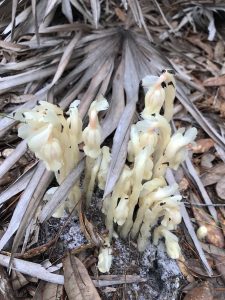
Ghost Pipes, Melbourne Florida. Photo by Green Deane
Several plants were called “Indian Pipes” where and when I was growing up. One of them is the Monotropa uniflora, recently seen in Wickham Park, Melbourne. Living more like a mushroom than a plant it sprouts up in various edibility conversations. Focusing the issue on exactly what “edibility” means, helps. Other than allergies, edibility does imply it will not kill you or harm you in any significant way. But “edibility” does not have to imply tasty. As forager emeratus Dick Deuerling (d. 2015) used to say “there are a lot of edible plants. I only eat the good stuff.” There are also things that are just too woody or bitter to eat more than a sample of but are included in “edible.” Sea Oxeye (Borrichia frutescens) comes to mind. And some plants have to be prepared correctly to be “edible.” Is the Monotropa uniflora edible? Yes. Does it taste good? Only if you’re really hungry. But that is understandable. The list of edible plants has to include everything from incredibly delicious food to only-if-I-were-starving food. Indian Pipes are closer to the famine food end of that list. The need a good sauce such as for asparagus. You can read more about the Monotropa here.

Classes are held rain or shine or cold. (Hurricanes are an exception.) Photo by Kelly Fagan.
Foraging Classes: Note below my annual urban crawl is coming up the last Friday before Christmas, warm or cold the class will go on. It has been held every year since 2008 (excepting one year I had surgery.)
Dec. 10th Mead Gardens, 1500 S. Denning Dr., Winter Park, FL 32789. 9 a.m. to noon Meet at the bathrooms. 9 a.m. to noon.
Dec. 16th, Eagle Park Lake, 1800 Keene Road, Largo, FL 33771. 9 a.m. to noon Meet at the pavilion near the dog park.
Dec. 17th, Bayshore Live Oak Park, Bayshore Drive. Port Charlotte. Meet at the parking lot at Ganyard and Bayshore, 9 a.m.
To read more about the classes, to pre-pay or sign up, go here.
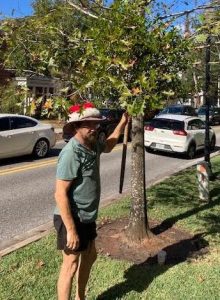
Finding Mistletoe during the 13th annual Urban Crawl in Winter Park.
My annual Urban Crawl #14 is coming up, on Dec. 22nd, 2023, in down town Winter Park. A reasonable question is what about foraging in a city? There is some surprising research. Dan Brabaner is a geoscience professor at Wellesley College, Boston. With some undergraduate students they studied preserved food collected from fruit trees and the like in the urban Boston area. What they found was cherries, apples, peaches and herbs were relatively low in lead and arsenic. That is, a serving had less amounts of these toxins than the allowed daily amount for a child. The team also did not find a significant difference between peeled and unpeeled fruit. The fruit was low in toxic chemical because they are the furthest away from any toxins in the soil. This would apply to tree nuts as well. Leafy greens faired well, too, because they grow fast and 1) don’t have time to accumulate toxins and 2) most air pollution on them can be washed off. Brabander also analyzed foraged food from plants growing in the urban environment not growing on agricultural soil. These foods had higher micronutrients because they were not growing on worn-out agricultural soil. Calcium and iron were higher as were manganese, zinc, magnesium and potassium. Thus we know that not only do “weeds” pack more of a nutritional punch because they are wild but also because they can be growing in better soil. My Urban Crawl is a free class Friday Dec. 22nd in Downtown Winter Park. We meet in front of Panera’s at 10 a.m. We wander south to the Rollin college, stop at Starbucks, go east to the public library area, then back to Panera’s, that takes a couple of hours. Park in the parking garage behind Paneras. If you park more than three hours on the streets of Winter Park you can get a ticket (this has happened in previous years.)
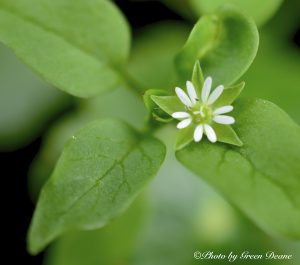 Real chickweed will soon arrive. If you want to sample it in a variety of ways you have a couple of months at best. I usually find chickweed locally between Christmas and Valentine’s Day. It can be found earlier and occasionally after Valentine’s Day. But those two holidays mark the practical beginning and end of the local chickweed season. It also doesn’t grow much farther south than central Florida. In northern climates Chickweed is a green of spring. It actually germinates under the snow so it can get a head start on other spring plants. Snow spits here every half century or so and the ground never freezes which is why we can forage 365 days a year. Chickweed is fairly easy to identify. Besides tasting like corn silk it has a stretchy inner core and one line of hair that runs along the stem switching sides at each pair of leaves. Don’t confuse Chickweed for a local cousin the edible, Drymaria cordata. To read more about chickweed click here. Also coming on strong is Pellitory. To read about Pellitory again click here.
Real chickweed will soon arrive. If you want to sample it in a variety of ways you have a couple of months at best. I usually find chickweed locally between Christmas and Valentine’s Day. It can be found earlier and occasionally after Valentine’s Day. But those two holidays mark the practical beginning and end of the local chickweed season. It also doesn’t grow much farther south than central Florida. In northern climates Chickweed is a green of spring. It actually germinates under the snow so it can get a head start on other spring plants. Snow spits here every half century or so and the ground never freezes which is why we can forage 365 days a year. Chickweed is fairly easy to identify. Besides tasting like corn silk it has a stretchy inner core and one line of hair that runs along the stem switching sides at each pair of leaves. Don’t confuse Chickweed for a local cousin the edible, Drymaria cordata. To read more about chickweed click here. Also coming on strong is Pellitory. To read about Pellitory again click here.

You get the USB, not the key.
172-video USB would be a good end of spring present and is now $99. My nine-DVD set of 135 videos has been phased out. The USB videos are the same videos I have on You Tube. Some people like to have their own copy. The USB videos have to be copied to your computer to play. If you want to order the USB go to the DVD/USB order button on the top right of this page. That will take you to an order form. I’d like to thank all of you who ordered the DVD set over the years which required me to burn over 5,000 DVDs individually.

Green Deane Forum
Want to identify a plant? Perhaps you’re looking for a foraging reference? You might have a UFO, an Unidentified Flowering Object, you want identified. On the Green Deane Forum we — including Green Deane and others from around the world — chat about foraging all year. And it’s not just about warm-weather plants or just North American flora. Many nations share common weeds so there’s a lot to talk. There’s also more than weeds. The reference section has information for foraging around the world. There are also
articles on food preservation, and forgotten skills from making bows to fermenting food.
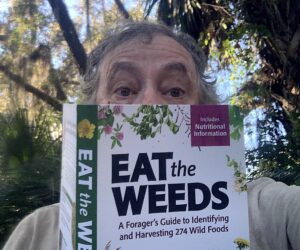
Finally, a physical copy of the book.
Now in print and delivered this week is EatTheWeeds, the book. It has 274 plants, 367 pages, index, nutrition charts and color photos. Several hundred have been pre-ordered on Amazon. Most of the entries include a nutritional profile and if no profile reported then noteworthy constituents. I have no doubt that the book will outlive me, my little contribution to posterity.
This is weekly newsletter #581. If you want to subscribe to this free newsletter you can find the sign-up form in the menu at the top of the page.

